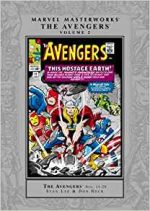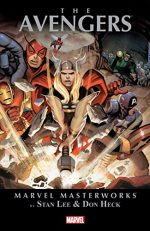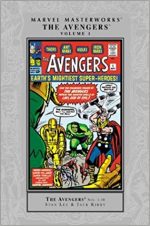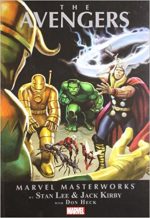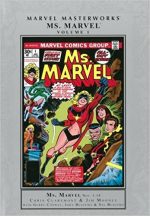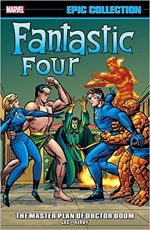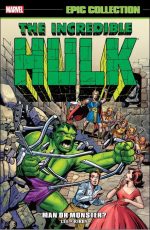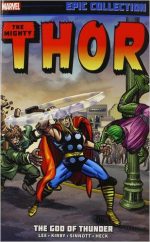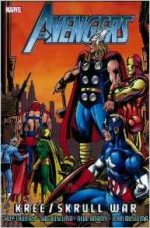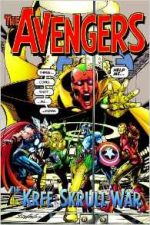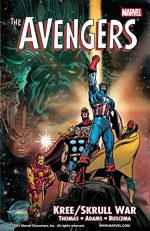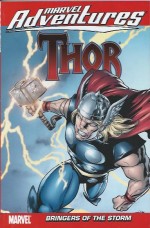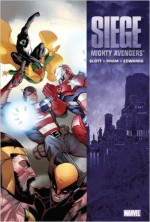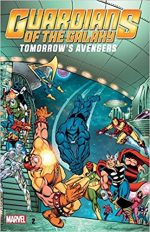
By Roger Stern, Jim Shooter, Chris Claremont, David Michelinie, Mark Gruenwald, Ralph Macchio, Bill Mantlo, Sal Buscema, George Pérez, David Wenzel, John Byrne, Jerry Bingham, Mike Vosburg, Bob McLeod, John Byrne, Ron Wilson & various (Marvel)
ISBN: 978-0-7851-6755-6
With more Marvel Cinematic movies doing bonanza summer business around the world, here’s a timely trade paperback collection designed to supplement cinematic exposure and cater to any film fans wanting to follow up with a comics experience. If you want you can look at this on screen, too, through its digital edition…
There are two distinct and separate iterations of the Guardians of the Galaxy. The films concentrate on the second, but there are inescapable connections between them and the stellar stalwarts here so pay close attention here…
The original comicbook team were freedom fighters united to defeat an invasion by reptilian Badoon aggressors. They comprised Charlie-27 – a heavy-gravity miner and militia-man from Jupiter – and crystalline scientist Martinex from Pluto. Both are examples of radical human genetic engineering: subspecies carefully designed to populate and colonise Sol system’s outer planets but now possibly the last of their kinds. They were joined in the struggle by 1000-year-old Earthman Major Vance Astro and Alpha Centauri aborigine Yondu. Astro had been humanity’s first intersolar astronaut; solo flying in cold sleep to Centauri at a plodding fraction of the speed of light. When he got there ten centuries later, humanity was waiting for him, having cracked trans-luminal speeds a mere two centuries after he took off…
A legion of 20th century heroes eventually helped banish the Badoon and save 31st century humanity, but peace was unsettling for the Guardians so they flew off in search of fresh adventure. Along the way they had picked up last Mercurian Nikki and an enigmatic space-god calling him/herself Starhawk…
This treasury of torrid tales gathers landmark moments from Thor Annual #6, Avengers #167-168; 170-177 & 180, Miss Marvel #23, Marvel Team-Up #86 and Marvel Two-In-One #61-63 and 69, cumulatively spanning December 1977 to November 1980 and featuring a radically different set-up than that of the silver screen stars, but grand comicbook sci fi fare all the same…
The time-busting mayhem commences with ‘Thunder in the 31st Century!’ (from Thor Annual #6, December 1977 by Roger Stern, Sal Buscema & Klaus Janson) in which the mighty Thunderer is accidentally summoned to the Guardians’ time period by a cyborg maniac named Korvac. The legendary hero joins them in bombastically battling a team of super-powered aliens to thwart the cyborg’s scheme to become master of the universe before returning to his own place and time…
An extended tour of duty with the Avengers then began courtesy of Jim Shooter, George Pérez & Pablo Marcos: an episodic, sprawling tale of time-travel and universal conquest which began in Avengers #167-168 (April and May 1978) and, after a brief pause, resumed for #170 through 177…
In previous issues a difference of opinion between Captain America and Iron Man over leadership styles had begun to polarise the team and tensions started to show in ‘Tomorrow Dies Today!’
In the Gods-&-Monsters filled Marvel Universe there are entrenched and jealous Hierarchies of Power, so when a new player mysteriously materialises in the 20th century the very Fabric of Reality is threatened…
It all kicks off when the Guardians of the Galaxy materialise in Earth orbit, hotly pursuing cyborg despot Korvac through time…
Inadvertently setting off planetary incursion alarms, their moon-sized ship Drydock is swiftly penetrated by an Avengers squad, where, after the customary introductory squabble, the future men force wearily explain the purpose of their mission…
Since Captain America had fought beside them to liberate their home era from Badoon rule and Thor had faced fugitive Korvac before, so peace soon breaks out, but even with the full resources of Earth’s Mightiest Heroes the time travellers are unable to locate their quarry…
Meanwhile on Earth a mysterious being named Michael is lurking in the background. At a fashion show staged by the Wasp he compels a psychic communion with model Carina Walters and they both vanish…
Avengers #168 reveals how ‘First Blood’ is drawn, stirring up more trouble as Federal liaison and hidebound martinet Henry Peter Gyrich begins making life bureaucratically hot for the maverick team. In Colorado, meanwhile, Hawkeye gets a shock as his travelling partner Two-Gun Kid vanishes before his eyes whilst in suburban Forest Hills, Starhawk – in his female iteration of Aleta – approaches a quiet residence…
Michael/Korvac’s scheme consists of subtly altering events as he gathers strength in secret preparation for a sneak attack on the era’s Cosmic Hierarchies. His entire plan revolves around not being noticed until he is too powerful to stop. When Starhawk confronts the future fugitive Michael kills the intruder and instantly resurrects him, but without the ability to perceive his assailant or any of his works…
After a two-issue break due to deadline problems Shooter, Pérez & Marcos pick up the drama in #170 with ‘…Though Hell Should Bar the Way!’
As Sentinel of Liberty and Golden Avenger finally settle their differences, in Inhuman city Attilan former Avenger Quicksilver suddenly disappears even as dormant mechanoid Jocasta (created by maniac AI Ultron to be his bride) goes on a rampage and escapes into New York City.
In stealthy pursuit and hoping her trail will lead to Ultron, the team stride into a fiendish trap ‘…Where Angels Fear to Tread’ but nevertheless triumph thanks to the hex powers of the Scarlet Witch, the assistance of pushy, no-nonsense new hero Ms. Marvel and Jocasta’s own rebellion against the metal monster who made her.
However, at their moment of triumph the Avengers are stunned to witness Cap and Jocasta winking out of existence…
The problems pile on in #172 as watchdog-come-gadfly Gyrich is roughly manhandled and captured by out-of-the-loop returnee Hawkeye and responds by rescinding the team’s Federal clearances.
Thus handicapped, the heroes are unable to warn other inactive members of the rapidly increasing disappearances as a squad of heavy-hitters rush off to tackle marauding Atlantean maverick Tyrak the Treacherous who is bloodily instigating a ‘Holocaust in New York Harbor!’ (Shooter, Sal Buscema & Klaus Janson)…
Answers to the growing mystery are finally forthcoming in ‘Threshold of Oblivion!’ – plotted by Shooter, with David Michelinie scripting for Sal Buscema & D(iverse) Hands to illustrate.
As the vanishings escalate, the remaining Avengers (Thor, Wasp, Hawkeye and Iron Man), with the assistance of Vance Astro, track down their hidden foe and beam into a cloaked starship to liberate the ‘Captives of the Collector!’ (by Shooter, Bill Mantlo, Dave Wenzel & Marcos)…
After a staggering struggle, the heroes triumph and their old arch-nemesis reveals a shocking truth: he is in fact an Elder of the Universe who foresaw cosmic doom millennia previously and sought to preserve special artefacts and creatures – such as the Avengers – from the slowly approaching apocalypse…
As he reveals that long-anticipated Armageddon is imminent and that he has sent his own daughter Carina to infiltrate The Enemy’s stronghold, the cosmic Noah is instantly obliterated in a devastating blast of energy. The damage however is done, and the entrenched Hierarchies of Creation may well be alerted…
Issue #175 starts the final countdown as ‘The End… and Beginning!’ (Shooter, Michelinie, Wenzel & Marcos) has the amassed ranks of Avengers and Guardians following the clues to Michael even as the new god shares the incredible secret of his apotheosis with Carina. ‘The Destiny Hunt!’ and ‘The Hope… and the Slaughter!’ (Shooter, Wenzel, Marcos & Ricardo Villamonte) then depict the entire army of champions destroyed and resurrected as Michael easily overpowers all opposition but falters at the crucial moment for lack of one fundamental failing…
Despite being somewhat let down by the artwork when the magnificent George Perez gave way to less enthusiastic hands such as Sal Buscema, David Wenzel and Tom Morgan, and cursed by the inability to keep a regular inker (Pablo Marcos, Klaus Janson Ricardo Villamonte and Tom Morgan all pitched in), the sheer scope of the epic plot nevertheless carries this story through to its cataclysmic and fulfilling conclusion. Even Shooter’s reluctant replacement by scripters Dave Michelinie and Bill Mantlo (as his editorial career advanced) couldn’t derail this juggernaut of adventure.
If you want to see what makes Superhero fiction work, and can keep track of nearly two dozen flamboyant characters, this is a fine example of how to make such an unwieldy proposition easily accessible to the new and returning reader.
A few months later Avengers#181 introduced new regular creative team Michelinie & John Byrne – augmented by inker Gene Day – as ‘On the Matter of Heroes!’ sees Agent Gyrich lay down the law and winnow the army of heroes down to a manageable and federally-acceptable seven.
With the Guardians of the Galaxy heading back to the future, Iron Man, Vision, Captain America, Scarlet Witch, Beast and Wasp have to placate Hawkeye after he is rejected in favour of new member The Falcon – parachuted in to conform to government quotas on affirmative action…
However, before the Guardians finally depart they interact with a few more 20th century centurions beginning with Ms. Marvel in ‘The Woman Who Fell to Earth’ (#23, April 1979 by Chris Claremont, Mike Vosburg & Bruce D. Patterson). When alien conqueror The Faceless One takes over Drydock, crusader-in-crisis Carol Danvers teams up with Vance Astro to expel the invader even though her career as Ms. Marvel is on its last legs…
In Marvel Team-Up #86 (October 1989), undercover Guardians Starhawk, Nikki and Martinex meet Spider-Man to prevent an unscrupulous reporter exposing the mission of the future heroes and publishing the ‘Story of the Year’ (Claremont & Bob McLeod)
Slightly out of chronology – but that’s time travel all over, right? – the remainder of this collection is given over to team-ups with old Guardians ally Ben Grimm, the Fantastic Four’s titanic Thing.
An extended interstellar epic opens in Marvel Two-In-One #61 with ‘The Coming of Her!’ (by Mark Gruenwald, Jerry Bingham & Gene Day) as time-travelling space god Starhawk becomes involved in the birth of a female counterpart to man-made man-god Adam Warlock.
The distaff genetic paragon awakes fully empowered and instantly starts searching for her predecessor, dragging Ben’s girlfriend Alicia Masters and mind goddess Moondragon (a future member of the 21st century Guardians of the Galaxy) across the solar system, arriving where issue #62 observes ‘The Taking of Counter-Earth!’
Hot on their heels Thing and Starhawk catch Her just as the runaway women encounter a severely wounded High Evolutionary and discover the facsimile Earth built by that self-made god has been stolen…
United in mystery, the strange grouping trail the planet out of the galaxy and expose the incredible perpetrators, but Her’s desperate quest to secure her predestined, purpose-grown mate ultimately ends in tragedy as she learns ‘Suffer Not a Warlock to Live!’
Then, from Marvel Two-In-One #69 (November 1980, by Gruenwald, Ralph Macchio, Ron Wilson & Day), ‘Homecoming!’ finds Ben clashing with the still time-displaced Guardians of the Galaxy whilst striving to prevent the end of everything after millennial man Vance Astro endangers all of reality by trying to stop his younger self ever going into space…
This spectacular selection of spectacular star-roving is a non-stop feast of tense suspense, surreal fun, swingeing satire and blockbuster action: another well-tailored, on-target tool to turn curious movie-goers into fans of the comic incarnation and another solid sampling to entice newcomers and charm even the most jaded interstellar Fights ‘n’ Tights fanatic…
© 1977, 1978, 1979, 1980, 2013 Marvel Characters, Inc. All rights reserved.
